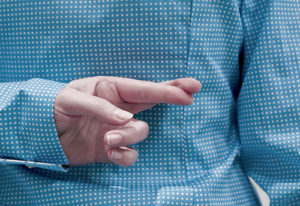 I’ve thought a lot about why people continue to give such terrible PowerPoint presentations. Certainly lack of time is an issue for many. And some feel they don’t have the skills to do better.
I’ve thought a lot about why people continue to give such terrible PowerPoint presentations. Certainly lack of time is an issue for many. And some feel they don’t have the skills to do better.
And others clearly don’t care—they just don’t think it’s that important to try and create a visually compelling set of slides.
But I’ve realized one of the biggest issues is this: many presenters are shamelessly cheating on their audiences.
Are You a Cheater?
Imagine you’re having a special someone over for a dinner date. You’re aware she’s a vegetarian, but you prepare steak. Why? Because you want to pass along the leftovers to your friends, and they’re all meat-eaters.
So they get warmed-over steak that’s not as good as when it’s fresh and your poor dinner companion has to sit there and stare at something that she can’t and won’t eat.
Nobody’s happy.
You’d never treat a dinner guest that way, right? But many people do this very thing to their audiences.
Don’t Be a Two-Timer
Speakers who cheat try to create a multipurpose presentation. One that can stand on its own as it gets passed around the office, and be understood by people who didn’t attend in person.
And that’s why you get those awful, ugly slide decks packed full of text. Not only are they terrible to look at, but the audience is reading the slides when they should be listening to the speaker.
(Though more than likely the speaker is himself reading aloud what’s on the screen, which is even worse.)
This doesn’t make much sense, does it? By gearing your presentation to people who aren’t there in the room, you’re cheating the audience that took the trouble to show up.
Love the Ones You’re With
So your first priority is to design a presentation for the people who are right there with you. That means your slides should act only as visual accompaniment, providing support for the words you say.
Take Seth Godin’s advice:
Talking about pollution in Houston? Instead of giving me four bullet points of EPA data, why not read me the stats but show me a photo of a bunch of dead birds, some smog and even a diseased lung?
Lots of pictures, very few words, no bullet points. It’s the formula Steve Jobs used.
But What About the Others?
Now it’s true that if you do your presentation this way, it won’t make much sense to those who see the deck later. Well, that’s actually a good thing. Here’s what Mitch Joel has to say on the subject:
The best presentations in the world are the ones where the slides are completely meaningless unless you have seen the speaker present them. Focus on that. Ensure that your slides act as a visual enhancement to everything that you’re saying. Why? Because if they don’t, it means that there was never a need to have the presenters there in the first place, because everything was self-evident from the words on the slides.
Of course it’s nice to share a presentation more widely, whether passing around a physical copy or putting it up online. But just as it’s cheating your live audience to give a presentation intended for others, it’s a dumb idea to just throw a deck full of images onto SlideShare. Nobody will get it.
You’re Going to Have to Work
The solution? You have to make two different decks. Yes, that’s a lot of work. So you have to ask yourself, are your ideas worth spreading? If so, they should be worth an investment of your time.
I’ve been wanting to use SlideShare for a while, but my slides are almost entirely images with very few words, and I couldn’t figure out how to make it work without my narration.
So I finally bit the bullet. I sat down and turned 11 Deadly Presentation Sins into a standalone presentation on SlideShare.
And it took a lot of time. About 20 hours. But I’m really happy with it.
Ask Yourself, Is It Worth It?
Whether that kind of investment is worth it to you is a decision you have to make for yourself. But by choosing not to do so, you’re sending a message about how much you value your ideas. And you may be saying that your time is worth more than your audience’s.
And that’s no way to treat people you presumably care about, it it?
The 11 Deadly Presentation Sins on SlideShare
I’m really pleased with how this first SlideShare turned out. It’s not as good as seeing the full presentation with my narration, but it’s a fair substitute.
And I feel like I don’t have to live a lie.
